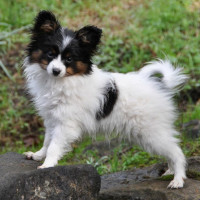Appearance of the Cavalon
|
| The Cavalon is a small to medium-sized dog. The two related breeds are particularly pretty, but have very different characteristics. Let's take the ears as an example. The Papillon owes its name to its erect ears, topped with extravagant silky hair, giving it the butterfly-wing appearance that gives it its name. The Cavalier, on the other hand, has long, floppy ears covered with long, curly fur. Most often, a Cavalon will be somewhere between these two types of ears, which could be described as dramatic, fur-covered ears. The Papillon gives the Cavalon a slightly longer, less blunt muzzle than the Cavalier, but those big, clear eyes remain a hypnotic feature. Their coat tends to be soft and of medium length on the body, with feathering on ears, legs and tail. The Cavalon color can be any combination of those found in parent breeds, such as ruby, ruby and white, Blenheim, black and tan or tan and white. |
Temperament of the Cavalon
|
| This small to medium-sized dog is better considered a canine companion than a working dog. Their good temperament makes them an ideal partner for families with older children. The slight hesitation in an unreserved recommendation comes from the Papillon parent. The latter can be shrewd and courageous at times, and if this trait shines through in the Cavalon, they can be a little intolerant and biting. Of course, as with any dog, good socialization as a young puppy is essential. While the Cavalier has an unblemished reputation, any puppy not exposed to a wide range of experiences from an early age can become restless and fearful. A happy Cavalier is playful and wants to be at the center of family life. They are lovers rather than fighters, so don't expect the Cavalon to be a guard dog, as they are more likely to ask for a belly rub than to get rid of an intruder. |
Needs and activities of the Cavalon
|
| Your Cavalon doesn't need enormous physical activity, but it does need regular exercise and play to stay fit and happy. As they don't like the cold, never leave them outside for long in winter, and try not to drive them too far in extreme temperatures. They don't bark much and will be happy to play in a house with a fenced-in yard, but will do just as well in an apartment as long as they're taken out every day. As intelligent, playful dogs, they will appreciate games that require mental stimulation to keep them happy and content. |
Maintenance of the Cavalon
|
| Cavalons will need a moderate amount of grooming, including regular brushing to keep the silky coat in good condition. You don't need to brush your dog more than twice a week, but regular brushing keeps the skin healthy by stimulating blood circulation. It also helps to remove loose hairs and prevent tangles from forming. Because of the long hairs on the ears, it's important to check them regularly for dirt or signs of irritation, and gently clean them with absorbent cotton. Brushing his teeth every day with a good canine toothpaste is a good habit to get into, and checking his nails often to see if they need trimming. |









 English (United Kingdom)
English (United Kingdom)